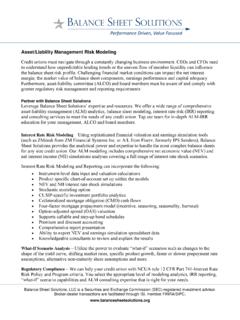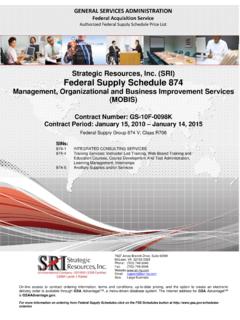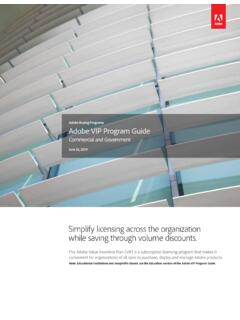Transcription of Examples of Benchmarking Reports in Higher …
1 1101 Pennsylvania Ave. NW, Suite 600 Washington, DC 20004 P F MARKET EVALUATION SURVEYING DATA ANALYSIS Benchmarking INNOVATIVE PRACTICES LITERATURE REVIEW Examples of Benchmarking Reports in Higher Education In the following pages, The Hanover Research Council provides Examples and links to a variety of Benchmarking Reports from Higher education institutions and associations. 2 HANOVER RESEARCH COUNCIL 2009 The Hanover Research Council APRIL 2009 Introduction A productive process that provides objective measurements for base-lining, goal-setting and improvement tracking, Benchmarking is an important component of self-evaluation for Higher education A review of the literature provides seven different Benchmarking methodology types, a variety of which are used in the Benchmarking study Examples provided in this report :2 Ideal type standards: A model is created based on idealized best practice, then used as the basis to assess institutions on the extent to which they fit the model.
2 Activity-based Benchmarking : Methodology in which a selected number of activities, which are either typical or representative of the range of institutional provision, are analyzed and compared with similar activities in other selected institutions. Activities may be considered solely on their own terms or may act as proxy for overall institutional performance. Vertical Benchmarking : Seeks to quantify costs, workloads, productivity, and performance of a defined functional area, for example the work of a student admissions department. As this approach is generally based upon existing organizational structures, data collection is often more straightforward than with other methods. Such initiatives may be limited to the investigation of a single activity or may be multi-dimensional. Horizontal Benchmarking : Seeks to analyze cost, workloads, productivity, and performance of a single process that cuts across one or more functional areas ( example : all aspects of student admissions irrespective of location within an institution).
3 Results provide a comprehensive view of institutional practice in any particular area, but data collection and interpretation may be problematic. Both horizontal and vertical benchmarks are useful diagnostic tools in identifying and prioritizing opportunities to improve an administrative process or function. Comparative/Competitive Benchmarking : Involves the use of institutions as comparative performance indicators. 1 Alstete, Jeffery W. Benchmarking in Higher Education: Adapting Best Practices to Improve Quality. ERIC Digest. < > 2 Quoted with slight variation from: Commonwealth Higher Education Management Service. Benchmarking in Higher Education: An International Review. Pg. 14-15. < > and Alstete, Jeffrey W. Benchmarking in Higher Education: Adapting Best Practices to Improve Quality: ERIC Education report No. 5. ERIC Clearinghouse on Higher Education.
4 Pg. 30-31. < > 3 HANOVER RESEARCH COUNCIL 2009 The Hanover Research Council APRIL 2009 Functional Benchmarking : Similar to comparative Benchmarking , except that the group of analyzed competitors is larger and more broadly defined. Generic Benchmarking : Also called best in class, it uses the broadest application of data collection from different kinds of organizations. The National Association of College and University Business Officers, which offers colleges and universities a wide variety of Benchmarking tools, also provides a data resources matrix that outlines types of available data and usage These data sources, profiled in the figure below, are generally used to varying extents in Higher education Benchmarking efforts. Figure 1: Benchmarking Data Resources Matrix Data Source Data Available Usage Restrictions General Integrated Postsecondary Education Data System (IPEDS) Enrollments, program completions, graduation rates, faculty and staff, finances, and student financial aid Available to public for free.
5 Most recent data available to institutions through password. Association of Governing Boards (AGB) Benchmarking Services Primarily IPEDS Data but does include other sources Available only to AGB members with an annual fee of $750 National Science Foundation Web CASPAR Includes selected IPEDS data and data from many NSF surveys including the Survey of Earned Doctorates, Survey of Federal Funds for R&D, etc Available to the public for free Endowment and Finance Data NACUBO Endowment Study Data on college and university endowment management and performance. Individual institution data on asset allocation, performance, and spending rate. Participants receive free access to results through NACUBO s Online Research Tool. Non-participants can purchase. Council for Aid to Education Voluntary Support of Education Data Miner Charitable support data report results can be purchased for $100, student participants receive a discount.
6 IPEDS Finance Survey Net assets, revenues, and expenditures, scholarships and fellowships. Available to the public for free. Delaware Study of Costs and Productivity Teaching loads, direct costs of instruction, and externally funded research and service productivity. Free to study participants. Moody s Municipal Financial Ratio Analysis (MFRA) Financial and operating credit statistics Subscription service providing access to the database and capability to create custom queries Facilities Data Association of Higher Education Facilities Officers (APPA) Facilities Core Data Survey Costs per square foot, building age and space use, and personnel costs and staffing levels. Free to survey participants. Available to non-participants for $230 or $150 for APPA members Society for College and University Data on physical size and growth Participants receive a complete data set. 3 National Association of College of University Business Officers.
7 Data Resources Matrix. < > 4 HANOVER RESEARCH COUNCIL 2009 The Hanover Research Council APRIL 2009 Data Source Data Available Usage Restrictions Planning (SCUP) Campus Facility Inventory patterns of colleges and universities. Data sets are not sold to non-participants. Salary and Benefits Data American Association of University Professor (AAUP) Salary Survey Data on tenure track and benefits of administrative compensation for senior executive positions. Selected tables are online and available to the public for free. Custom peer comparisons and datasets available for purchases. Full report available to AAUP members for free and can be purchased by non-members. College and University Professional Association for Human Resources DataOnDemand Several salary and benefit surveys, including administrative compensation, mid-level administrative compensation, faculty salary and employee health benefits. DataOnDemand is available for a subscription fee, based on membership status.
8 IPEDS HR Survey Staff and faculty salaries, benefits, classification and tenure status. Available to the public for free. Benchmarking Survey of Human Resource Practices in Higher Education Strategic planning, staffing and compensation, benefits, training and development and performance assessment. Participants receive a custom report and access to the Data Analysis System. Tuition Discounting Data NACUBO Tuition Discounting Survey Institutional student aid, percent of students receiving institutional grants, net revenues, and other related information. Participants receive free access to results and an online tool, the NACUBO Benchmarking Tool, for peer comparison purposes. Non-participants can purchase results through the NACUBO s bookstore. Figure from: National Association of College of University Business Officers. Data Resources Matrix. 5 HANOVER RESEARCH COUNCIL 2009 The Hanover Research Council APRIL 2009 Examples of Benchmarking Reports in Higher Education The Pennsylvania State University Benchmarking Procurement Practices in Higher Education The current economic recession has affected all levels of industry, including Higher education.
9 In addition to a weakening financial situation, American institutions of Higher education can expect to face increasing scrutiny on their spending and finances. In order to address these changes in the economic and regulatory environment, it is important that colleges and universities address their procurement practices. This study, conducted via a collaboration between Pennsylvania State University s Center for Supply Chain Research and IBM s Public Sector Procurement Consulting Practice, seeks to benchmark the procurement practices of a variety of Higher education institutions in order to improvement both the efficiency and effectiveness of Higher education procurement practices. Methodology The Benchmarking study used a comparative Benchmarking approach that examined cross-organizational contrasts and similarities. The study sought to measure and evaluate how colleges and universities conduct expenditures and to identify trends in procurement within and across schools.
10 Institutional Benchmarking occurred across 18 criteria that corresponded to key elements of best-in-class procurement practices. These criteria were divided into the following categories: Spend Analysis Purchasing Strategies Purchasing Organization Purchasing Process Performance Measurement The institutions were ranked on each Benchmarking criteria on a relative scale that ranged from 0=no response, 2=average participation/performance, and 3=leading participation/performance. Additionally, seven internal measurement criteria were used: Total dollars spent Dollars spent through P-cards Dollars spent through group agreements Cost savings Contract utilization 6 HANOVER RESEARCH COUNCIL 2009 The Hanover Research Council APRIL 2009 Number of suppliers Supplier consolidation efforts Results Key findings related to each of the Benchmarking criteria categories are as follows: Spend Analysis: The institutions studied are not exploiting the use of spend analysis to drive value.





